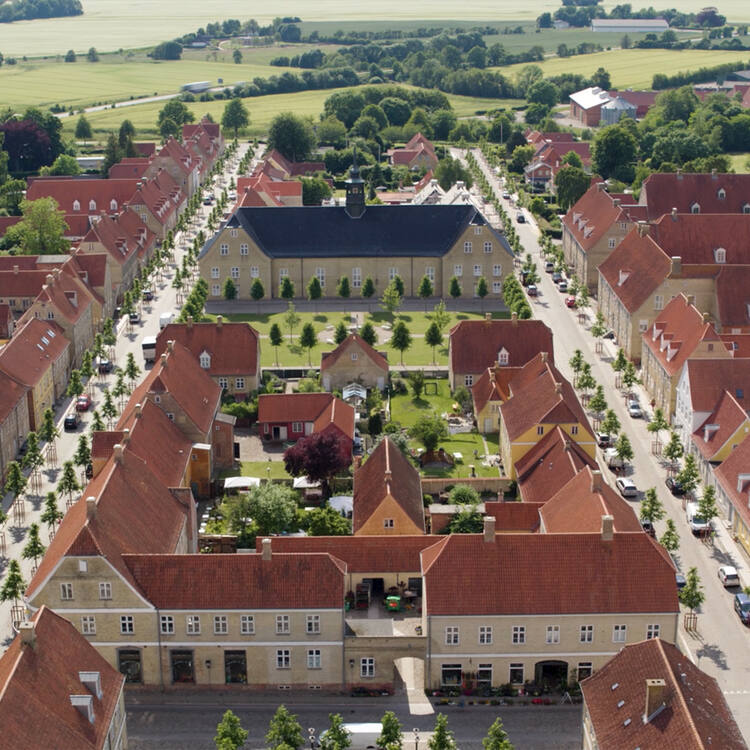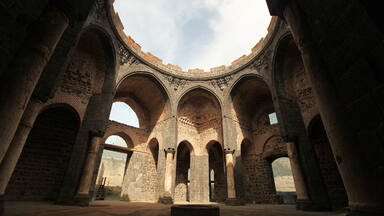Christiansfeld, a Moravian Church Settlement
Christiansfeld, a Moravian Church Settlement
Founded in 1773 in South Jutland, the site is an example of a planned settlement of the Moravian Church, a Lutheran free congregation centred in Herrnhut, Saxony. The town was planned to represent the Protestant urban ideal, constructed around a central Church square. The architecture is homogenous and unadorned, with one and two-storey buildings in yellow brick with red tile roofs. The democratic organization of the Moravian Church, with its pioneering egalitarian philosophy, is expressed in its humanistic town planning. The settlement’s plan opens onto agricultural land and includes important buildings for the common welfare such as large communal houses for the congregation’s widows and unmarried men and women. The buildings are still in use and many are still owned by the local Moravian Church community .
Description is available under license CC-BY-SA IGO 3.0
Christiansfeld, une colonie de l’Église morave
Fondée en 1773 en Jutland du Sud, cette colonie est un exemple de peuplement planifié de l’Eglise morave, une congrégation libre luthérienne basée à Herrnhut, en Saxe. Conçue comme le modèle de l’idéal urbain protestant, la ville s’est développée autour d’une église centrale et de sa place. Les maisons, de plain-pied ou à un étage, présentent des façades en briques jaunes homogènes sans ornement et des toits en tuile rouge. L’organisation démocratique de l’Eglise morave, qui fut pionnière en matière d’idées d’égalité, s’exprime dans son urbanisme humaniste. Celui-ci est illustré par son plan ouvert sur des terres agricoles et ses bâtiments importants pour le bien commun, à l’image des maisons collectives pour les veuves et les célibataires. Elle sont toujours habitées et l’Eglise morave local est toujours propriétaire de beaucoup de ces maisons.
Description is available under license CC-BY-SA IGO 3.0
كريشتشانزفلد، مستعمرة تابعة للكنيسة المورافية
أنشئت هذه المستعمرة في عام 1773 في جوتلاند الجنوبية، وهي مثال على المستوطنات المنظمة للكنيسة المورافية التابعة للمذهب اللوثري والتي تتخذ من هرنهوت (ساكس) مقراً لها. وشيِّدت مدينة كريشتشانزفلد لتكون نموذجاً للمناطق الحضرية البروتستانتية وقد تطورت حول كنيسة مركزية وباحتها. وتتميز منازل المدينة المبنية إما على مستوى واحد أو من طابق واحد بواجهات متجانسة من القرميد الأصفر لا تحمل أي زخرفات، وبسقوف من القرميد الأحمر. ويتجلى التنظيم ذو الطابع الديمقراطي للكنسية المورافية، التي كانت سباقة في تعزيز مبادئ المساواة بين الجنسين، في التصميم المدني الإنساني الذي اتّبعته والذي يتميز بمساحات تطل على الأراضي الزراعية وبأبنية عامة كبيرة، منها المنازل الجماعية المخصصة للأرامل والعزباوات. وتسكن في المدينة حتى اليوم جماعة واسعة النفوذ تابعة للكنيسة المورافية.
source: UNESCO/CPE
Description is available under license CC-BY-SA IGO 3.0
克里斯丁菲尔德,摩拉维亚居留区
这座1773年建于南日德兰半岛上的遗迹是路德派自由教会摩拉维亚教派建在萨克森州贺恩护特的一片有计划的聚居区。这座小镇原计划要表现新教徒的理想城市规划。围绕着市中心的教会广场,所有的建筑外形统一、质朴,都是一到二层的黄砖红瓦结构。摩拉维亚教派民主的组织结构和前卫的平等理念都在这座小镇的人文规划中体现出来。小镇四周被农田包围,镇里还有重要的公共福利建筑,如为教区寡妇和单身男女而建的公共大屋。这些建筑至今仍为摩尔维亚教派中很有影响力的一个社团所用。
source: UNESCO/CPE
Description is available under license CC-BY-SA IGO 3.0
Кристиансфельд – поселение Моравской церкви
Колония Кристиансфельд, основанная в 1773 году на юге Ютландии, является ярким примером планового заселения новых территорий, проводимого Моравской церковью – свободной лютеранской конгрегацией, основанной в Саксонии, в городе Хернхут (Гернгут). Основатели Кристиансфельда стремились создать эталон протестантского градостроительства. Поселение выросло вокруг церкви на центральной площади. Само поселение состоит из однотипных одно- или двухэтажных домов с гладкими желтыми кирпичными фасадами без декоративных элементов и крышами из красной черепицы. Демократические идеи Моравской церкви, которая одной из первых начала строго придерживаться гуманистических принципов равенства, нашли отражение в её подходе к градостроительству. Так, сельскохозяйственные земли и городские сооружения, имеющие большое значение для общего блага, следуют открытому плану застройки с использованием коммунальных домов-общежитий для одиноких. В Кристиансфельде по-прежнему проживает влиятельная община Моравской церкви.
source: UNESCO/CPE
Description is available under license CC-BY-SA IGO 3.0
Christiansfeld, una colonia de la iglesia morava
Esta ciudad de Jutlandia Meridional tiene su origen en la colonia fundada en 1773 por la Iglesia Morava, una congregación libre luterana con sede en Herrnhut (Sajonia). Es un ejemplo de asentamiento humano planificado, concebido con arreglo al ideal urbanístico protestante de desarrollo de la ciudad en torno a una iglesia central y su correspondiente plaza. Las viviendas tienen una o dos plantas en general y se caracterizan tanto por sus fachadas homogéneas de ladrillos de color amarillo, sin ornamento alguno, como por sus techumbres de tejas rojas. La organización democrática de la Iglesia Morava, precursora de los ideales de igualdad entre los hombres, se refleja en el carácter humanitario del urbanismo: plano abierto de la ciudad hacia las tierras agrícolas y presencia de edificios importantes para el bien común de la población, como las casas colectivas para personas viudas y solteras. En Christiansfeld todavía vive en nuestros días una influyente comunidad de la Iglesia Morava.
source: UNESCO/CPE
Description is available under license CC-BY-SA IGO 3.0
モラヴィア教会の入植地 クリスチャンフェルド
クリスチャンフェルドは、ユトランド半島南部に18世紀に建設された、モラヴィア教会の入植地。教会の社会的および倫理的理想を反映した類いまれな入植地の一つで、中央広場を中心に建設された、北ヨーロッパ入植地の最もよく保存された事例である。黄色の煉瓦に赤瓦の屋根をいただく1~2階建ての建物は、均一で装飾がなく、平和と調和を重んじる独特な雰囲気を醸す。この町は、ほかのモラヴィア教会の入植地と同様、平等や社会共同体など後にヨーロッパの多くの地域に広まった啓蒙思想を反映している。source: NFUAJ
Christiansfeld, een Moravische kerknederzetting
Christiansfeld is gesticht in 1773 in Zuid-Jutland. De site is een voorbeeld van een geplande nederzetting van de Moravische Kerk, een Lutherse vrije congregatie gecentreerd rond Herrnhut, Saksen. De stadsplanning vertegenwoordigt het protestantse stedelijke ideaal en is opgebouwd rondom een centraal kerkplein. De architectuur is homogeen en zonder opsmuk, met gebouwen in gele baksteen en rode pannendaken. De democratische organisatie van de Moravische Kerk, met zijn baanbrekende egalitaire filosofie, wordt uitgedrukt in haar humanistische stadsplanning. De nederzetting staat open naar landbouwgronden in de omgeving en bevat belangrijke gebouwen voor het algemeen welzijn, zoals grote gemeenschappelijke huizen voor weduwen en ongehuwde mannen en vrouwen. De gebouwen worden nog steeds gebruikt door een invloedrijke gemeenschap van de Moravische Kerk.
Source: unesco.nl
Outstanding Universal Value
Brief synthesis
The 18th century settlement of Christiansfeld in South Jutland is an exceptional example of a Moravian Church planned colony settlement, which reflects the Moravian Church’s societal and ethical ideals. Founded in 1773, it was built as a colony of the Moravian Church, a Lutheran free congregation centred in Herrnhut, Saxony. Christiansfeld is one of many exceptional settlements, and it presents the best-preserved example of a northern European colony settlement constructed around a central Church Square. The town presents an intact and well-preserved collection of buildings, oriented along two tangential east-west streets surrounding the Church Square and integrates a cemetery placed outside of the town. The town reflects the Moravian Church’s societal structure, characterised by large communal houses for the congregation’s widows and unmarried men and women. The architecture is homogenous and unornamented, with one- and two-storey buildings in yellow brick and with red tile roofs. The proportions, materials, and craftsmanship contribute to the town’s special atmosphere of peace and harmony.
Criterion (iii): The Moravian Church settlement of Christiansfeld bears an exceptional testimony to the Brethren’s principles, which are expressed in the town’s layout, architecture and craftsmanship as well as the fact that numerous buildings are still used for their original functions and the Moravian Church activities and traditions are continued. Its exceptional state of preservation allows Christiansfeld to be recognized as the best preserved and most complete example of a European Moravian Church colony illustrating urban planning principles aimed at reflecting the social and ethical values of this community.
Criterion (iv): Christiansfeld is an outstanding example of a planned idealized Protestant colony, as is illustrated in its town plan, unity and functional distribution, in which the Moravian Church’s vision of an urban society could be realized. Like other Moravian settlements, it reflects new ideas introduced in the Age of Enlightenment which anticipated ideas of equality and social community that became a reality for many Europeans only much later. The democratic organisation of the Moravian Church is expressed in its humanistic town planning, illustrated by its open plan, established on agricultural land and representing all important buildings for the common welfare. Christiansfeld possesses all necessary town functions and illustrates its unity through homogenous groups of buildings with shared styles, materials, proportions and a high quality of craftsmanship.
Integrity
The boundaries of the property include the complete original town plan of Christiansfeld and with it all elements that were planned as part of the Moravian Church settlement. A large percentage of the original buildings have been preserved and the town plan remains widely legible. The religious rituals and beliefs of the community, which are the reason for the design of physical spaces, are to a large extent continuously practiced. The visual relations between different parts of the town, including the cemetery and the landscape surrounding it, are still extant. Christiansfeld, due to its excellent state of preservation, illustrates the highest number of characteristic elements found in any European Moravian Church colony settlement and therefore demonstrates integrity. In terms of the overall network of Moravian settlements, further elements could contribute to Christiansfeld’s integrity by means of a future serial transnational nomination of Moravian Church Settlements into which Christiansfeld could be integrated.
Authenticity
The structure and characteristics of the original town plan remain largely unaltered. All buildings, especially those of the early Moravian period of 1820, retain their authenticity in material, design, substance, workmanship, and some of them as well in function and use. The continuity of the Moravian Church community contributes to safeguarding authenticity in spirit and feeling as well as atmosphere of the property. Most of the residential units have been modernized in their interiors to be in line with contemporary living standards whilst aiming to retain their authenticity wherever possible. In some cases architectural renovations could have been implemented with more respect for authenticity. At times architects have aimed for modern interiors of a high aesthetic standard and refinery which have unfortunately reduced traces of historic construction materials and techniques. It is recommended that future modernizations, including of interiors, should pay special attention to the preservation of historic surfaces.
Protection and management requirements
The key historic buildings in Christiansfeld are protected according to the Buildings and Urban Environment Act (Act No. 685 of 9 June 2011). The entire property is protected by Local Planning Act 1311-41 which lays down the rules for the area’s use, land development, roads, trails and parking, wiring systems, the development’s size and location, the development’s outward appearance, etc. World Heritage Sites, according to Danish legislation, are by definition sites of national interest and any approvals granted by the municipality need to be reviewed by the Minister of the Environment. While the protection by planning act seems sufficient and effective at present, planning acts are agreed upon for limited timeframes and may change in the future. Since a national interest has been added with the World Heritage designation, ideally the entire property should be designated as a historic monument at the highest possible level in the national designation system. The Moravian Church has for the past 200 years provided traditional protection to its buildings through their requirements for use.
The management and administration is shared by several partners in a so-called UNESCO Management Group and a Group of Interested Parties. The municipality has allocated funds earmarked for the preservation of Christiansfeld and the Moravian Church has recently established a committee under the Board of Elders for conservation, renovation and maintenance decisions. A senior craftsman employed by the Moravian Church is in charge of the execution of decisions concerned. The State Party has indicated that a risk preparedness and disaster response plan will be developed for the property by 2016.
The management plan predominantly aims at the preservation and protection of Christiansfeld with regards to its town plan, historic architecture and landscape setting. The plan combines a list of specific measures divided into three areas; urban, architectural and cultural, to be undertaken in the forthcoming four years. The current priorities and actions are intended to be implemented up until 2017, when a comprehensive evaluation and revision of the management plan is envisaged. Quality assessment indicators for the evaluation of its implementation are yet to be finalized. The management plan is yet to be officially adopted but the different actions contained in it have been endorsed by either the Kolding Municipality or the Management Group. The Moravian Church community remains very active in upholding its religious and social services. These also form opportunities for involvement in the social and ethical principles that underline the significance of the settlement.


